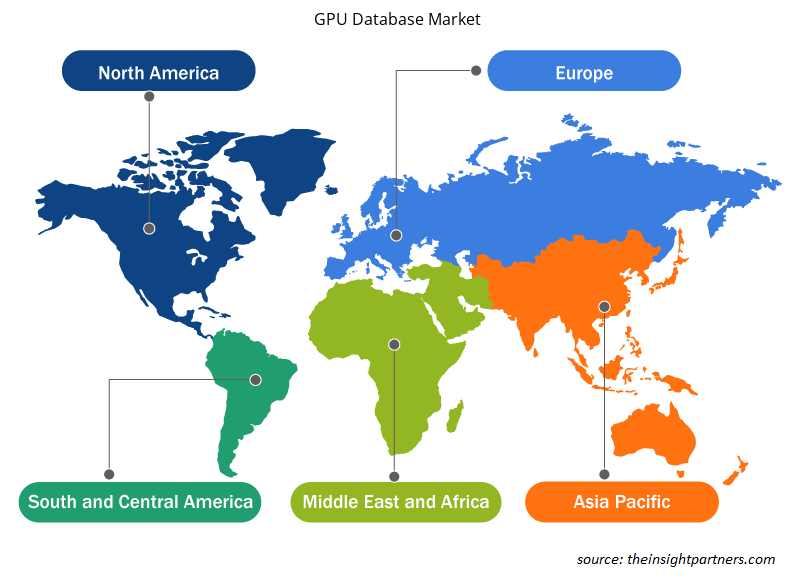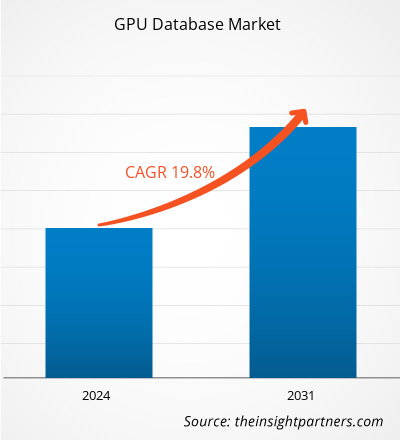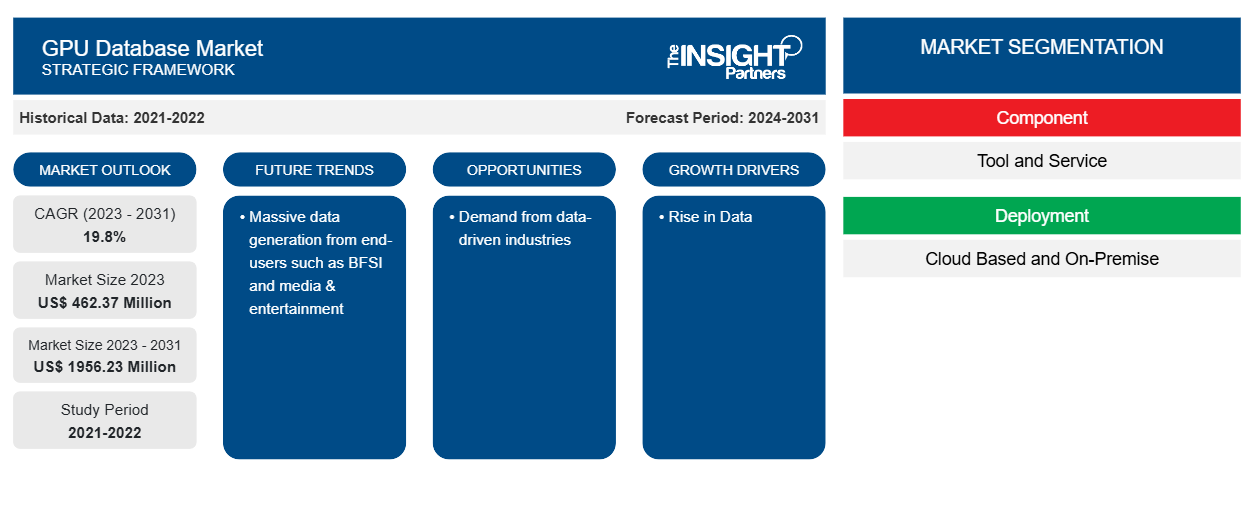GPU 데이터베이스 시장 규모는 2023년 4억 6,237만 달러에서 2031년 1,956.23만 달러로 성장할 것으로 예상됩니다. 이 시장은 2023~2031년 동안 19.8%의 CAGR을 기록할 것으로 예상됩니다. 데이터의 증가와 성장하는 데이터 중심 산업은 시장의 주요 트렌드로 남을 가능성이 높습니다.
GPU 데이터베이스 시장 분석
성장하는 데이터 중심 산업은 GPU 데이터베이스 시장의 주요 원동력 중 하나입니다. 디지털화의 증가와 대규모 데이터 세트를 처리하는 솔루션에 대한 기업의 성향이 시장 성장을 촉진하고 있습니다. GPU 데이터베이스는 인공 지능, 머신 러닝 및 딥 러닝, 사물 인터넷(IoT), 지리공간 분석과 같은 일부 신흥 기술에 적용되어 GPU 데이터베이스 시장 성장에 큰 기회를 창출합니다.
GPU 데이터베이스 시장 개요
GPU 데이터베이스는 그래픽 처리 장치(GPU)를 사용하여 데이터베이스 작업을 수행합니다. GPU는 고해상도 이미지와 비디오를 빠르게 렌더링하도록 설계된 프로그래밍 가능한 프로세서입니다. GPU 데이터베이스는 순차적으로가 아닌 병렬로 작동하기 때문에 CPU보다 방대한 데이터 볼륨을 더 빠르고 효과적으로 처리합니다. 따라서 GPU 데이터베이스는 일반적으로 더 빠르고 분석에 맞춰져 있어 다양한 유형의 데이터나 훨씬 더 많은 양의 데이터를 처리하는 데 더 유연합니다.
귀하의 요구 사항에 맞게 이 보고서를 사용자 정의하세요
이 보고서의 일부 또는 국가 수준 분석, Excel 데이터 팩을 포함하여 모든 보고서에 대한 사용자 정의를 무료로 받을 수 있으며 신생 기업 및 대학을 위한 훌륭한 혜택과 할인 혜택을 이용할 수 있습니다.
- 이 보고서의 주요 시장 동향을 알아보세요.이 무료 샘플에는 시장 동향부터 추정 및 예측까지 다양한 데이터 분석이 포함됩니다.
GPU 데이터베이스 시장 동인 및 기회
시장 호조를 위한 데이터 증가
디지털화의 도래와 함께 데이터가 엄청난 속도로 생성됩니다. 다양한 종류, 볼륨, 속도의 데이터를 분석하고 처리하여 데이터 분석 기술의 도움으로 숨겨진 패턴과 통찰력을 수행해야 합니다. 기존 분석은 최적의 분석 기술과 기술을 제공하지 못합니다. 이로 인해 GPU 데이터베이스가 필요합니다. 대량 병렬 처리 기능을 갖춘 GPU 데이터베이스는 비용 효율적으로 고성능 컴퓨팅을 제공합니다. GPU 데이터베이스는 대용량 데이터 세트를 처리하는 데 이상적인 솔루션으로, 이 기술에 대한 수요를 촉진합니다.
데이터 중심 산업의 수요.
GPU 데이터는 높은 연산 능력을 가지고 있습니다. 병렬 처리 기능 덕분에 그림과 같이 CPU만 포함된 구성보다 최대 100배 더 빠르게 데이터를 처리할 수 있습니다. 따라서 BFSI, 미디어 및 엔터테인먼트와 같은 다양한 데이터 중심 산업은 데이터 분석 애플리케이션에 대한 처리 집약적 워크로드에 대한 솔루션을 요구하며, 이는 GPU 데이터베이스에 대한 수요를 촉진합니다. 시장 참여자들은 이러한 수요를 충족하기 위한 솔루션을 출시하고 있습니다. Graphistry는 고객에게 GPU 가속 시각적 그래프 분석을 제공하기 위해 Hub Pro(전문가용 Graphistry Hub)를 출시했습니다. Graphistry Hub Pro는 개인을 위한 보안, 가격 책정 및 유지 관리와 팀을 위한 곧 출시될 Hub Organizations를 해결합니다. (출처: Graphistry, 보도 자료, 2021년 9월)
GPU 데이터베이스 시장 보고서 세분화 분석
GPU 데이터베이스 시장 분석에 기여한 주요 세그먼트는 구성 요소, 배포, 애플리케이션 및 산업 분야입니다.
- 구성 요소를 기준으로 GPU 데이터베이스 시장은 도구와 서비스로 나뉩니다. 도구 세그먼트는 2023년에 시장에서 가장 큰 점유율을 차지했습니다.
- 배포에 따라 시장은 클라우드 기반과 온프레미스로 세분화됩니다. 클라우드 기반은 가장 높은 CAGR로 성장할 것으로 예상됩니다.
- 응용 프로그램별로 시장은 사기 탐지 및 예방, 거버넌스 위험 및 규정 준수(GRC), 고객 경험 관리, 예측 유지 관리, 공급망 관리, 위협 인텔리전스 등으로 세분화됩니다. 고객 경험 관리가 2023년에 시장에서 상당한 점유율을 차지했습니다.
- 산업 수직별로 시장은 BFSI, IT & 텔레콤, 리테일 & 전자상거래, 헬스케어, 운송 & 물류, 정부 & 국방, 기타로 세분화됩니다. BFSI는 2023년에 시장에서 상당한 점유율을 차지했습니다.
지역별 GPU 데이터베이스 시장 점유율 분석
GPU 데이터베이스 시장 보고서의 지리적 범위는 주로 북미, 아시아 태평양, 유럽, 중동 및 아프리카, 남미 및 중미의 5개 지역으로 나뉩니다.
아시아 태평양 지역은 가장 높은 CAGR로 성장할 것으로 예상됩니다. 인도와 중국과 같은 개발도상국의 디지털화 증가와 고급 데이터 분석 기술에 대한 수요 증가가 이 지역의 시장 성장을 견인하고 있습니다. BFSI, 의료, 제조 등과 같은 데이터 중심 산업 전반의 디지털 전환이 시장 성장을 더욱 촉진하고 있습니다. 대규모 데이터 세트에서 통찰력을 추출하려는 수요가 증가하면서 아시아 태평양의 시장 성장이 촉진되고 있습니다.
GPU 데이터베이스 시장 지역 통찰력
Insight Partners의 분석가들은 예측 기간 동안 GPU 데이터베이스 시장에 영향을 미치는 지역적 추세와 요인을 철저히 설명했습니다. 이 섹션에서는 북미, 유럽, 아시아 태평양, 중동 및 아프리카, 남미 및 중미의 GPU 데이터베이스 시장 세그먼트와 지리적 분포도 논의합니다.

- GPU 데이터베이스 시장을 위한 지역별 데이터 얻기
GPU 데이터베이스 시장 보고서 범위
| 보고서 속성 | 세부 |
|---|---|
| 2023년 시장 규모 | 4억 6,237만 달러 |
| 2031년까지 시장 규모 | 19억 5,623만 달러 |
| 글로벌 CAGR (2023-2031) | 19.8% |
| 역사적 데이터 | 2021-2022 |
| 예측 기간 | 2024-2031 |
| 다루는 세그먼트 | 구성 요소별로
|
| 포함된 지역 및 국가 | 북아메리카
|
| 시장 선도 기업 및 주요 회사 프로필 |
|
GPU 데이터베이스 시장 플레이어 밀도: 비즈니스 역학에 미치는 영향 이해
GPU 데이터베이스 시장 시장은 소비자 선호도의 변화, 기술 발전, 제품의 이점에 대한 인식 증가와 같은 요인으로 인해 최종 사용자 수요가 증가함에 따라 빠르게 성장하고 있습니다. 수요가 증가함에 따라 기업은 제품을 확장하고, 소비자의 요구를 충족하기 위해 혁신하고, 새로운 트렌드를 활용하여 시장 성장을 더욱 촉진하고 있습니다.
시장 참여자 밀도는 특정 시장이나 산업 내에서 운영되는 회사나 기업의 분포를 말합니다. 주어진 시장 공간에 얼마나 많은 경쟁자(시장 참여자)가 존재하는지 그 규모나 전체 시장 가치에 비해 나타냅니다.
GPU 데이터베이스 시장에서 운영되는 주요 회사는 다음과 같습니다.
- 브릿릿
- 그래픽 디자인
- H2O.ai
- 제독스
- 키네티카 DB 주식회사
- 네오포제이 주식회사
면책 조항 : 위에 나열된 회사는 어떤 특별한 순서에 따라 순위가 매겨지지 않았습니다.

- GPU 데이터베이스 시장의 주요 기업 개요를 알아보세요
GPU 데이터베이스 시장 뉴스 및 최근 개발
GPU 데이터베이스 시장은 1차 및 2차 연구 이후의 질적, 양적 데이터를 수집하여 평가합니다. 여기에는 중요한 기업 출판물, 협회 데이터 및 데이터베이스가 포함됩니다. GPU 데이터베이스 시장의 몇 가지 개발 사항은 다음과 같습니다.
- NVIDIA와 HP Inc.는 생성 AI 개발의 기반을 형성하는 데이터 준비 및 처리 작업을 가속화하기 위해 NVIDIA CUDA-X 데이터 처리 라이브러리를 HP AI 워크스테이션 솔루션과 통합한다고 발표했습니다. NVIDIA CUDA 컴퓨팅 플랫폼에 구축된 CUDA-X 라이브러리는 테이블, 텍스트, 이미지 및 비디오를 포함한 광범위한 데이터 유형에 대한 데이터 처리 속도를 높입니다. 여기에는 NVIDIA RAPIDS cuDF 라이브러리가 포함되어 있으며, 이 라이브러리는 CPU 전용 시스템 대신 NVIDIA RTX 6000 Ada Generation GPU를 사용하여 코드를 변경하지 않고도 pandas 소프트웨어를 사용하는 거의 1,000만 명의 데이터 과학자의 작업을 최대 110배까지 가속화합니다. (출처: NVIDIA, 보도자료, 2024년 3월)
- 벡터 데이터베이스 기술 의 선구자인 Zilliz는 Milvus 2.4 출시를 발표했으며, RAPIDS cuVS 라이브러리의 일부인 NVIDIA의 CUDA-Accelerated Graph Index for Vector Retrieval(CAGRA)로 구동되는 획기적인 GPU 인덱싱 기능으로 벡터 검색 기능의 새로운 표준을 제시했습니다. (출처: Zilliz, 보도자료, 2024년 3월)
GPU 데이터베이스 시장 보고서 범위 및 제공물
"GPU 데이터베이스 시장 규모 및 예측(2021-2031)" 보고서는 아래 영역을 포괄하는 시장에 대한 자세한 분석을 제공합니다.
- 범위에 포함된 모든 주요 시장 세그먼트에 대한 글로벌, 지역 및 국가 수준의 GPU 데이터베이스 시장 규모 및 예측
- GPU 데이터베이스 시장 동향 및 드라이버, 제약, 주요 기회와 같은 시장 역학
- 자세한 PEST/포터의 5가지 힘과 SWOT 분석
- 주요 시장 동향, 글로벌 및 지역 프레임워크, 주요 업체, 규정 및 최근 시장 개발 사항을 포괄하는 GPU 데이터베이스 시장 분석
- 시장 집중도, 히트맵 분석, 유명 업체 및 GPU 데이터베이스 시장의 최근 개발 사항을 다루는 산업 환경 및 경쟁 분석
- 자세한 회사 프로필
- 과거 분석(2년), 기준 연도, CAGR을 포함한 예측(7년)
- PEST 및 SWOT 분석
- 시장 규모 가치/거래량 - 글로벌, 지역, 국가
- 산업 및 경쟁 환경
- Excel 데이터세트
최근 보고서
사용 후기
구매 이유
- 정보에 기반한 의사 결정
- 시장 역학 이해
- 경쟁 분석
- 고객 인사이트
- 시장 예측
- 위험 완화
- 전략 기획
- 투자 타당성 분석
- 신흥 시장 파악
- 마케팅 전략 강화
- 운영 효율성 향상
- 규제 동향에 발맞춰 대응





















 무료 샘플 받기 - GPU 데이터베이스 시장
무료 샘플 받기 - GPU 데이터베이스 시장